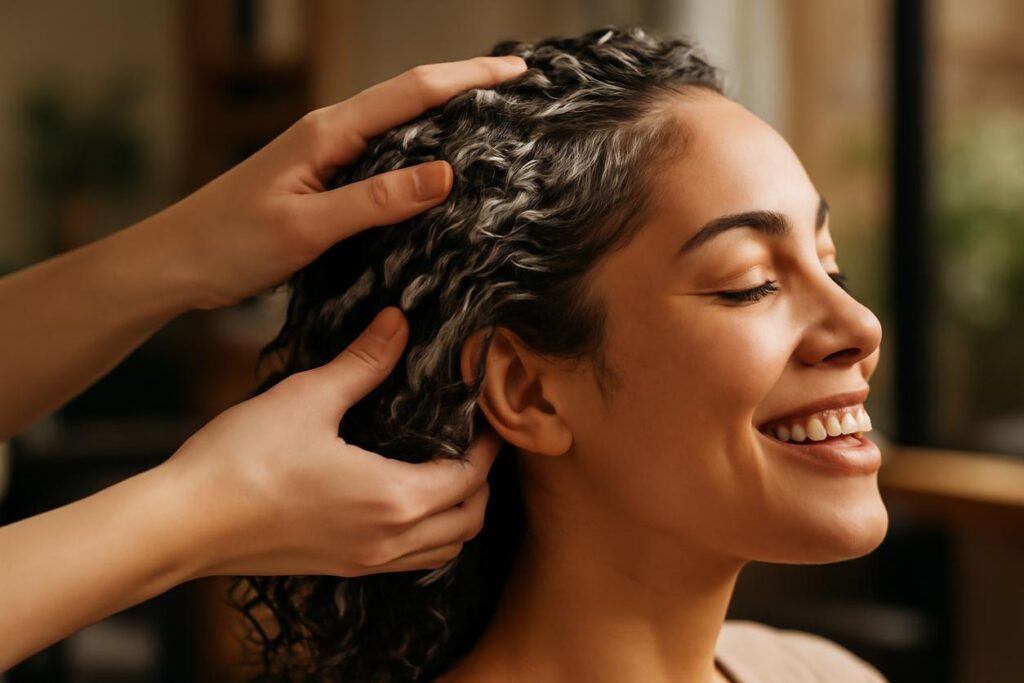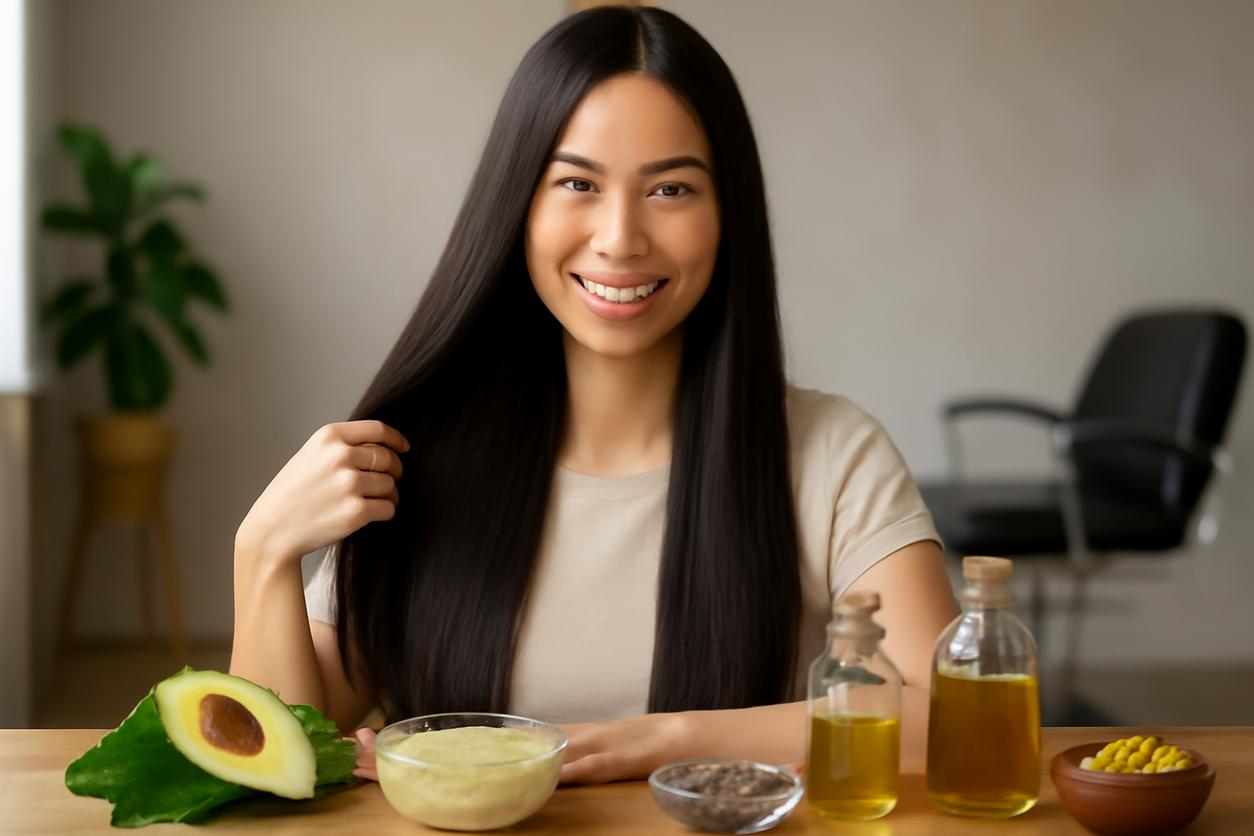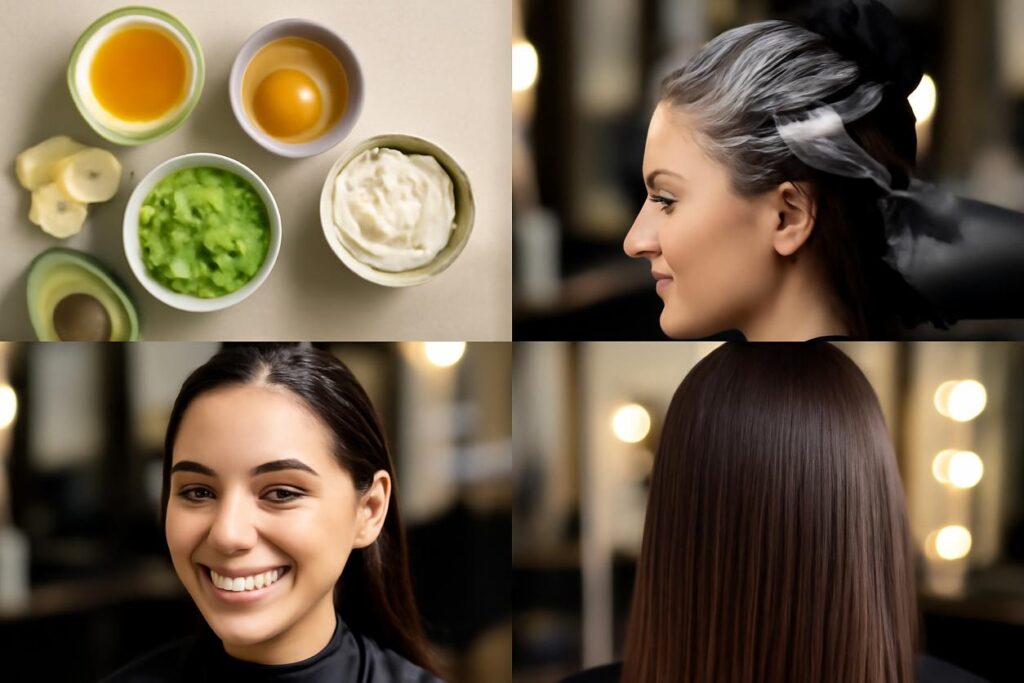Table of Contents
- What is Co-Washing?
- Benefits of Co-Washing
- Who Benefits Most (Hair Types & Concerns)
- Co-Washing vs Shampooing: Practical Comparison
- Ingredients to Seek and Avoid (Plain-Language)
- Step-by-Step Co-Wash Routine by Hair Texture
- Frequency, Timing and Water Quality Considerations
- How to Pair Co-Washing with Styling and Treatments
- Troubleshooting Common Issues
- Simple At-Home Co-Wash Recipes (Gentle, Natural)
- FAQs
- Further Reading & Rich Hair UK Resources
For decades, the hair care mantra has been a simple one: lather, rinse, repeat. We’ve been taught that a rich, foamy lather is the only way to achieve truly clean hair. But what if that squeaky-clean feeling is actually a cry for help from your hair, stripped of its natural, protective oils? For those with hair that is naturally dry, textured, or fragile, traditional shampooing can lead to a cycle of dryness, frizz, and breakage. It’s time to rethink cleansing. Enter co-washing, a gentler, moisture-focused approach that is transforming hair health for countless people.
This guide will dive deep into the world of conditioner-only washing, demystifying the science, providing practical routines for your specific hair type, and empowering you to make the best choices for your hair’s unique needs.
What is Co-Washing?
Co-washing is short for “conditioner-only washing.” It’s the practice of using a specific type of conditioner, or a product labelled as a “cleansing conditioner” or “co-wash,” to cleanse your hair and scalp instead of a traditional shampoo. This might sound counterintuitive—how can a conditioner clean your hair? The answer lies in basic hair science.
Traditional shampoos use strong detergents called surfactants (like sulfates) to break down dirt, oil, and product build-up. While effective, they are often too harsh and strip away the natural oils, or sebum, that keep your hair moisturised and protected. Conditioners also contain very mild surfactants (often called “cationic surfactants”) that can gently lift away grime and excess oil without being stripping. When you co-wash, you use the friction of your fingertips to manually scrub the scalp, allowing these gentle cleansing agents to do their job while the conditioning ingredients simultaneously hydrate and soften your hair.
Benefits of Co-Washing
Switching to a co-washing routine can offer a wealth of benefits, particularly for hair that craves moisture. The primary goal is to cleanse without stripping, leading to a healthier hair ecosystem.
- Enhanced Moisture Retention: This is the number one benefit. By not stripping away natural oils, co-washing helps your hair retain its inherent moisture, leaving it softer and more pliable.
- Reduced Frizz and Flyaways: Frizz is often a sign of dry, dehydrated hair. A well-moisturised hair cuticle lies flat, resulting in smoother strands and better-defined curls or waves.
- Improved Elasticity and Reduced Breakage: Dry, brittle hair snaps easily. The conditioning agents in a co-wash improve hair’s elasticity, making it more resilient to stress from styling and manipulation.
- Softer, More Manageable Hair: Regular co-washing can transform the texture of your hair, making it feel significantly softer and easier to detangle and style.
- Better Curl and Wave Definition: For those with textured hair, moisture is key to definition. Co-washing helps curl patterns clump together beautifully without being weighed down by harsh cleansing agents.
Who Benefits Most (Hair Types & Concerns)
While anyone can try co-washing, certain hair types and conditions will see the most dramatic improvements. If you identify with any of the following, conditioner washing could be a game-changer for you.
- Curly and Coily Hair (Types 3-4): The twists and turns of curly and coily hair make it difficult for scalp oils to travel down the hair shaft. This makes these hair types naturally prone to dryness, and co-washing provides much-needed moisture.
- Wavy Hair (Type 2): Wavy hair can easily be weighed down or dried out. A lightweight co-wash can cleanse effectively while encouraging wave patterns and fighting frizz.
- Dry or Damaged Hair: Whether your hair is dry from chemical processing, heat styling, or just genetics, co-washing helps replenish lost moisture and prevent further damage.
- Thick, Coarse Hair: This hair type can often feel rough and straw-like. Co-washing helps to soften the hair cuticle, leading to a smoother, more manageable texture.
- Color-Treated Hair: Harsh sulfates in shampoos are notorious for stripping hair color. Co-washing is a much gentler alternative that can help preserve the vibrancy and longevity of your dye job.
Co-Washing vs Shampooing: Practical Comparison
Understanding the fundamental differences between these two cleansing methods can help you decide which approach is right for your routine.
| Feature | Traditional Shampoo | Co-Wash / Cleansing Conditioner |
|---|---|---|
| Primary Purpose | Deep cleansing, removal of all oils and build-up. | Gentle cleansing, moisture retention, and conditioning. |
| Key Cleansing Agents | Strong surfactants (e.g., Sodium Lauryl Sulfate). | Very mild surfactants and conditioning agents. |
| Effect on Natural Oils | Strips away most natural oils (sebum). | Preserves a healthy level of natural oils. |
| Resulting Feel | Squeaky-clean, sometimes dry or tangled. | Soft, hydrated, and smooth. |
| Ideal Frequency | 1-3 times per week, depending on hair type. | Can be used multiple times per week, even daily for some. |
Ingredients to Seek and Avoid (Plain-Language)
Not all conditioners are created equal, and using the wrong one for co-washing can lead to build-up. Here’s a simple breakdown of what to look for and what to steer clear of.
Ingredients to Seek in a Co-Wash:
- Humectants: These are moisture magnets. Look for ingredients like glycerin, aloe vera, and panthenol that draw water into the hair shaft.
- Emollients: These ingredients smooth the hair cuticle and lock in moisture. Good examples are shea butter, cetyl alcohol, and natural oils like jojoba or avocado oil.
- Gentle Cleansing Agents: Look for terms like Behentrimonium Methosulfate (don’t worry, it’s not a harsh sulfate!) or Cetrimonium Chloride. These have mild cleansing properties.
- Proteins: Ingredients like hydrolyzed wheat protein or keratin can help fill in gaps in the hair cuticle, strengthening damaged hair. Use these in moderation if your hair is protein-sensitive.
Ingredients to Avoid for Co-Washing:
- Harsh Sulfates: The main culprits you’re trying to avoid! These include Sodium Lauryl Sulfate (SLS) and Sodium Laureth Sulfate (SLES).
- Non-Water-Soluble Silicones: Silicones like dimethicone can give hair a slippery, shiny feel, but they can also build up over time, requiring a harsh shampoo to remove. This defeats the purpose of co-washing.
- Heavy Oils and Waxes: Ingredients like mineral oil and petrolatum can be too heavy for many hair types, weighing them down and causing greasy build-up.
Step-by-Step Co-Wash Routine by Hair Texture
The key to successful co-washing is technique. It requires more manual effort than shampooing to ensure your scalp is properly cleansed.
Wavy Hair Routine (Type 2)
The goal for wavy hair is to cleanse without weighing it down. Choose a lightweight co-wash.
- Saturate: Thoroughly wet your hair with lukewarm water.
- Apply: Use a generous amount of co-wash (think a 50p coin size to start, adding more if needed). Emulsify it between your palms and apply directly to your scalp.
- Scrub: Using the pads of your fingers (not your nails!), scrub your entire scalp for 2-3 minutes. This friction is what cleanses.
- Rinse & Reapply: Rinse thoroughly. If your hair feels like it needs more moisture, apply a small amount to the lengths and ends and let it sit for a minute.
- Final Rinse: Rinse completely, scrunching your hair upwards to encourage wave formation.
Curly Hair Routine (Type 3)
Curls need significant moisture and slip to prevent tangles and encourage definition.
- Saturate: Make sure your hair is soaking wet. This helps distribute the product evenly.
- Apply: Section your hair into 4-6 parts. Apply a palmful of co-wash to the scalp of the first section.
- Scrub Vigorously: Spend at least 3-5 minutes scrubbing your scalp section by section. This is the most crucial step for a clean scalp.
- Distribute and Detangle: Once the scalp is clean, smooth the remaining product down the lengths of your hair. Use your fingers or a wide-tooth comb to gently detangle while the conditioner provides slip.
- Rinse: Rinse thoroughly, but some may prefer to leave a tiny amount in on the ends for extra moisture (often called “squish to condish”).
Coily/Kinky Hair Routine (Type 4)
This hair type is the most fragile and prone to dryness, requiring the most moisture and gentle handling.
- Saturate: Work in sections under running water to ensure every strand is fully wet.
- Apply Liberally: Be generous with your co-wash. Apply to the scalp and lengths of each section.
- Focus on the Scalp: Gently but firmly massage your scalp with your fingertips for at least 5 minutes total, working through each section.
- Detangle with Care: Add more co-wash if needed for slip. Carefully detangle each section from the ends up to the roots using your fingers.
- Let it Sit: Allow the co-wash to sit on your hair for a few minutes, like a mini-conditioning treatment.
- Rinse: Rinse thoroughly with lukewarm water.
Straight & Low-Porosity Routine
While less common, those with straight but dry hair or low-porosity hair (which resists moisture) can benefit from occasional co-washing. The key is to avoid build-up.
- Use Sparingly: Start with a very small amount of a very lightweight co-wash.
- Scalp Only: Focus application and scrubbing entirely on the scalp for 1-2 minutes.
- Quick Rinse: As you rinse, the product will run down and lightly condition your ends. This is usually enough.
- Alternate: It’s often best for this hair type to alternate co-washing with a gentle, sulfate-free shampoo to prevent build-up.
Frequency, Timing and Water Quality Considerations
Optimizing your co-washing routine involves more than just technique. Looking ahead to strategies for 2025 and beyond, personalizing your schedule is key.
- Frequency: How often you co-wash depends on your hair type and lifestyle. Coily hair might co-wash 1-2 times a week, while someone with wavy hair who exercises daily might co-wash 4-5 times a week. Listen to your hair. If it feels dry, it’s time to wash.
- Timing: The “scrub time” is non-negotiable. Aim for at least 3-5 minutes of vigorous scalp massage to effectively cleanse. This is where co-washing differs from a quick shampoo.
- Water Quality: The water in your home plays a huge role. Hard water is high in mineral deposits that can build up on the hair, causing it to feel dull and dry. If you have hard water, it’s crucial to incorporate a clarifying shampoo into your routine every 2-4 weeks to remove these mineral deposits, which a co-wash alone cannot do. Soft water is much gentler on hair and makes co-washing more effective.
How to Pair Co-Washing with Styling and Treatments
A co-wash routine doesn’t exist in a vacuum. It must work with your other products for the best results.
- Clarifying: Everyone who co-washes needs to clarify. This means using a shampoo with stronger (but still preferably sulfate-free) surfactants to remove any product, oil, or mineral build-up. Plan to clarify every 2-6 weeks, depending on your hair’s needs.
- Deep Conditioning: Co-washing provides daily moisture, but a weekly or bi-weekly deep conditioning treatment is still essential for repairing and intensely hydrating the hair shaft. Apply it after clarifying for maximum absorption.
- Styling Products: Stick to water-soluble styling products (gels, mousses, creams) that can be easily rinsed out. Heavy, silicone-based stylers will cause build-up that a co-wash can’t remove.
Troubleshooting Common Issues
If your co-washing journey hits a snag, don’t give up! These common issues are usually easy to fix.
- Issue: My hair feels greasy or weighed down.
Solution: You may be using too much product, a conditioner that’s too heavy for your hair type, or you’re not scrubbing your scalp long enough. Try a lighter-weight formula and increase your scrub time to a full 5 minutes. It might also be time to clarify. - Issue: My scalp feels itchy or flaky.
Solution: This is a sign that your scalp isn’t getting clean enough. Ensure you are scrubbing every part of your scalp vigorously. If the problem persists, you may need to alternate co-washing with a gentle medicated or sulfate-free shampoo. - Issue: My hair looks limp and has no volume.
Solution: Focus the co-wash application only on the scalp and the very ends. Make sure you are rinsing thoroughly, as leftover product can weigh hair down. A final rinse with cool water can also help close the cuticle and add lift.
Simple At-Home Co-Wash Recipes (Gentle, Natural)
While dedicated co-wash products are formulated for optimal performance, you can try these gentle, natural recipes at home. Note: these are best for occasional use as they lack the preservatives and balanced formulation of commercial products.
1. Aloe & Coconut Milk Soother
- Ingredients: 1/2 cup pure aloe vera gel, 1/4 cup full-fat coconut milk.
- Directions: Whisk ingredients together until smooth. Apply to a wet scalp and hair, scrubbing gently for 3-5 minutes before rinsing thoroughly. Best for dry, irritated scalps.
2. Avocado & Honey Hydrator
- Ingredients: 1/2 a very ripe avocado, 2 tablespoons of honey, a little water to thin.
- Directions: Blend all ingredients until completely smooth (no chunks!). Apply to damp hair, focusing on the scalp and lengths. Massage for several minutes, then rinse completely. This is very moisturizing and great for damaged hair.
FAQs
Can I use my regular conditioner to co-wash?
You can, but it’s crucial to check the ingredients first. Ensure it is free of non-water-soluble silicones. Conditioners specifically marketed as “co-washes” are often formulated to be lighter and have slightly better cleansing properties.
Will co-washing make my hair fall out?
No. When done correctly, co-washing is gentle on the hair and scalp. You might notice more hairs in the drain on wash day, but this is simply the accumulation of hairs that would have normally shed over the previous few days. A healthy scalp sheds about 50-100 hairs daily.
How long does it take to see results from co-washing?
Some people notice an immediate improvement in softness and moisture after the first wash. However, it can take 2-4 weeks for your hair and scalp to fully adjust to the new routine, especially if you are transitioning from using harsh sulfate shampoos.
Further Reading & Rich Hair UK Resources
Your journey to healthier, more hydrated hair is just beginning. To continue learning, explore our detailed resources.
-
For a refresher on the foundational concepts, visit our guide on Co-Washing Basics.
-
Explore our curated selection of cleansing conditioners in the Rich Hair UK Co-Wash Picks collection.
-
Dive deeper into the ‘why’ behind hair behaviour with our Hair Science Overview.
-
Confused by an ingredient label? Decode it with our helpful Ingredient Glossary.






